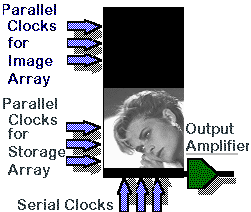Frame-Transfer CCDs
A frame-transfer CCD has its parallel register divided into two distinct areas: the image array, where images are focused, and the storage array, where the integrated image is temporarily stored prior to readout.
Typically, the storage array is identical in size to the image array and is covered with an opaque mask to shield the pixels from light. It is important to note that not all the pixels are used for imaging. Some pixels near the perimeter can be used for reference to compensate for certain electronic offsets. After the image array is exposed to light, the entire image is rapidly shifted to the storage array. While the masked storage array is being read, the image array integrates charge for the next image.
Critical to frame-transfer operation are two sets of parallel register clocks that independently shift charge on either the image or storage array. Thus, a frame-transfer CCD can operate continuously without a shutter at high frame rates. Finally, a frame-transfer CCD can be used in conjunction with a mechanical shutter to acquire two images in rapid succession. This mode can be used when two images need to be acquired at different excitation or emission wavelengths, as is the case for certain ion-imaging experiments.

